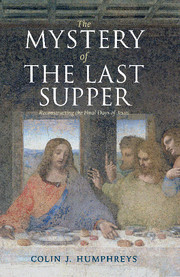Book contents
- Frontmatter
- Contents
- List of illustrations
- Foreword by I. Howard Marshall
- Acknowledgements
- 1 Four mysteries of the last week of Jesus
- 2 Dating the crucifixion – the first clues
- 3 The problem of the last supper
- 4 Can we reconstruct the Jewish calendar at the time of Christ?
- 5 The date of the crucifixion
- 6 The moon will be turned to blood
- 7 Did Jesus use the solar calendar of Qumran for his last supper Passover?
- 8 Does ancient Egypt hold a key to unlocking the problem of the last supper?
- 9 Discovering the lost calendar of ancient Israel
- 10 Was the lost ancient Jewish calendar used in Israel at the time of Jesus?
- 11 The date of the last supper: the hidden clues in the gospels
- 12 From the last supper to the crucifixion: a new analysis of the gospel accounts
- 13 A new reconstruction of the final days of Jesus
- Notes
- Bibliography
- Index of biblical and other ancient sources
- General index
4 - Can we reconstruct the Jewish calendar at the time of Christ?
Published online by Cambridge University Press: 03 May 2011
- Frontmatter
- Contents
- List of illustrations
- Foreword by I. Howard Marshall
- Acknowledgements
- 1 Four mysteries of the last week of Jesus
- 2 Dating the crucifixion – the first clues
- 3 The problem of the last supper
- 4 Can we reconstruct the Jewish calendar at the time of Christ?
- 5 The date of the crucifixion
- 6 The moon will be turned to blood
- 7 Did Jesus use the solar calendar of Qumran for his last supper Passover?
- 8 Does ancient Egypt hold a key to unlocking the problem of the last supper?
- 9 Discovering the lost calendar of ancient Israel
- 10 Was the lost ancient Jewish calendar used in Israel at the time of Jesus?
- 11 The date of the last supper: the hidden clues in the gospels
- 12 From the last supper to the crucifixion: a new analysis of the gospel accounts
- 13 A new reconstruction of the final days of Jesus
- Notes
- Bibliography
- Index of biblical and other ancient sources
- General index
Summary
Some of Judaism's most profound truths are to be found, not in texts but in time, in the Jewish calendar itself.
(Jonathan Sacks, the Chief Rabbi of Britain and the Commonwealth)The Jewish calendar must have been at least as central to the lives of Jewish people at the time of Christ as our calendar is to us today. For example, on Nisan 1, in the spring of each year, Jews would have marked the start of their religious year (their civil year, used for official purposes, started in the autumn). In the first two weeks of Nisan, Jewish people would have travelled from many countries to Jerusalem to celebrate the great Feast of Passover. On Nisan 10 they would have selected a Passover lamb for sacrifice at the temple in Jerusalem on Nisan 14, as instructed in the book of Exodus. On Nisan 15 they would have eaten their Passover meal and remembered the events of the Exodus. On Nisan 16 they might have watched the barley being harvested in the fields, after seeing the priests waving the first sheaves of barley in the temple earlier that day, as specified in the book of Leviticus, and so on.
The Jewish calendar must have been so central to the lives of Jewish people in the first century ad, for both religious and agricultural reasons, that to my mind it is simply not credible that the traditions handed down by eye-witnesses to the gospel writers were confused about whether Jesus died on Nisan 14 or 15, particularly because these two days, when the Passover lambs were slain, roasted and eaten, were the most important days in the whole year in the Jewish calendar.
- Type
- Chapter
- Information
- The Mystery of the Last SupperReconstructing the Final Days of Jesus, pp. 39 - 60Publisher: Cambridge University PressPrint publication year: 2011



